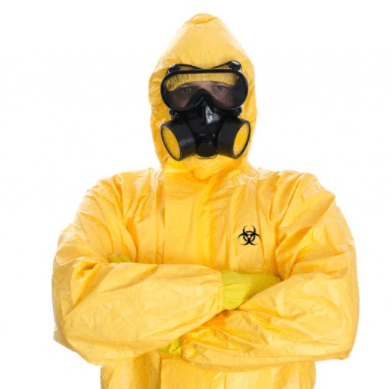The Top 5 Uses for a Hazmat Suit

All hazmat suits have one purpose: keep the person wearing it alive. The person who wears a hazmat suit should be in the same condition when they take it off that they were when they put it on. Anything less that that is simply unacceptable.
The COVID-19 pandemic has made more people more aware of what healthcare professionals and military personnel have known for decades: hazmat suits save lives. The term “personal protection equipment (PPE)” has entered the lexicon of the entire world. We have all become more closely acquainted with the importance of using technology to design and construct, through industrial sewing, hazmat suits that keep people safe.
First, What Is a Hazmat Suit?
A hazmat suit is personal protective equipment (PPE) designed to create an impermeable barrier to hazardous materials or biological and chemical agents. It is a whole-body garment that is usually combined with a breathing apparatus (self-contained system) to provide a steady supply of breathable air regardless of the environment it is being used in.
Where and How are Hazmat Suits Used?
1. Hospitals
It should be no surprise that, especially in the times of COVID, hospitals are where we are most likely to see hazmat suits in our day-to-day lives. When a deadly and highly-infectious respiratory disease takes hold in a region, the patients in the most dire condition also require the most care and hands-on treatments like intubations. Even a routine blood draw or blood pressure check can potentially expose a caregiver or medical professional to disease. A hazmat suit with appropriate ventilation and adequate seals can make all the difference.
2. Outbreaks
When Ebola struck West Africa in 2016, hazmat suits with medical-grade protection were literally life-savers. Medical personnel and other volunteers mobilized across the continent to lend any assistance they could, which meant close contact with patients suffering from the ravages of Ebola. Although not a respiratory virus, the fatality rates and ease of transmission, especially in developing countries, made hazmat suits a necessity.
3. Industrial Settings
While the variety of medical settings is wide and varied, another use for hazmat suits that you’re likely to encounter out in the world is when a different kind of respiratory threat emerges in old buildings and asbestos is found to have been used in its construction. Also, molds of various kinds can also become a threat to people living or working in them. Workers tasked with removing those threats from those buildings must wear something to protect themselves from these environmental dangers.
4. Wartime
During the defense of Kuwait during Operation Desert Storm, American troops were mobilized in military action against Saddam Hussein. In his other conflicts in the region, he was known to use chemical weapons. As a precaution against possible exposure to threats like Sarin and mustard gas, American troops were issued various kinds of hazmat suits and other equipment that provided protection from poisonous weapons. Thankfully, the threat never materialized into actual weapons being used against American troops.
5. The DPE
Vinyl Technology has been the sole supplier of the Demilitarization Protective Ensemble in service of the United States Department of Defense since the mid 1990s. The initial project was a concerted effort by the USA to eradicate chemical weapon inventories. In order to protect its personnel from dangerous environments in which these weapons were often stored, they needed a custom-made, chemical-resistant, air-tight suit that could also be created in large numbers. Although volume has changed over the years as demand shifts, production of DPE suits is always ongoing.
Do All Hazmat Suits Offer the Same Protection?
Similar to the different levels of PPE , hazmat suits come in 4 different levels of protection as defined by the EPA, ranging from Level A to Level D. Of critical importance, level A is defined as being required when the greatest potential for exposure to hazards exists. Specifically, this level of hazmat suit must confer the greatest level of skin, respiratory, and eye protection.
According to the EPA:
Examples of Level A clothing and equipment include:
-
positive pressure, full face-piece self contained breathing apparatus (SCBA) or positive pressure supplied air respirator with escape SCBA;
-
totally encapsulated chemical- and vapor-protective suit;
-
inner and outer chemical-resistant gloves; and
-
disposable protective suit, gloves, and boots.
Are Hazmat Suits Reusable?
Hazmat suits are often designed to be disposable because of the safety concerns inherent in their exposure to infected particles, radiation, or chemical agents. As you might imagine, this presents difficulty when it comes to prolonged usage or deployment on a hazardous site for long periods of time. Not only is cost a concern, but the need to be able to trust the quality of different hazmat suits to avoid suit failure to ensure the safety of the person wearing it. It is of critical importance to work with a reputable hazmat suit manufacturer as it can be a literal life-or-death situation.
Why Choose Vinyl Technology for your Hazmat Suits?
Vinyl Technology has a 99.8% on-time fulfillment rate and has a rigorous quality assurance and testing program. Vinyl Technology is an ITAR compliant and ISO certified hazmat suit manufacturer capable of large production runs to meet your hazmat suit needs. Contact us today to request a quote on a hazmat suit or other custom sewn products or heat sealing projects.
